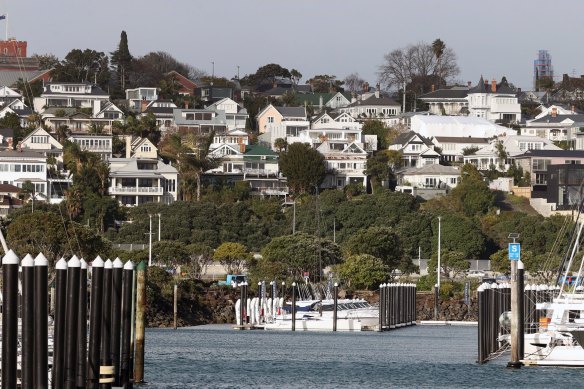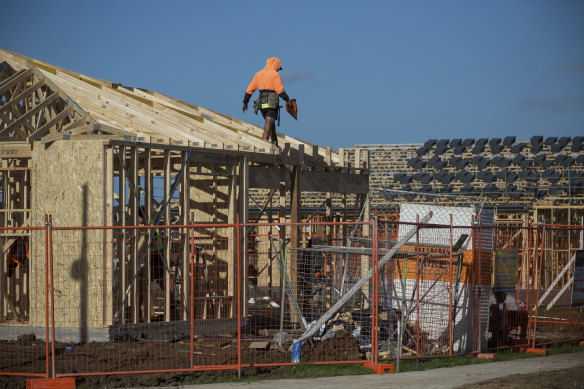This was published 2 years ago
Increasing density might be the answer to housing costs, research shows
The broad scale relaxation of planning rules leads to a significant increase in housing supply, new research into New Zealand planning changes has found.
A similar approach could help property prices and rents in Australia fall by as much as 12.5 per cent, making housing more affordable, economists said.

Auckland increased its housing stock by 5 per cent in five years thanks to relaxed planning laws. Credit: Bloomberg
Auckland “up-zoned” about three quarters of the city in 2016 in response to a housing affordability crisis, which meant the planning laws allowed for the construction of townhouses, terraces and units within 20 kilometres of the CBD.
In the past five years, New Zealand’s second-largest city has built an extra 5 per cent – or 26,903 – homes, the report, The Impact of Up-zoning on Housing Construction in Auckland from the Cowles Foundation for Research in Economics at Yale University, found.
One of the report authors, and University of Auckland associate professor of economics, Dr Ryan Greenaway-McGrevy said that the “close-to-blanket” relaxed planning laws helped to increase housing supply significantly.
“The punchline is the policy did encourage, certainly, higher rates of construction and dwelling stock,” Greenaway-McGrevy said. “And it will increase overtime.”
It was in contrast with other evidence around the world, including an often-cited example in Chicago where only transit lines were up-zoned, covering just 6 per cent of the city. This failed to increase housing construction significantly, Greenaway-McGrevy said.
“The point of difference [in Auckland] is just the sheer pervasiveness of the up-zoning policy. We’re not talking about transit-oriented up-zoning areas. We’re talking about the close-to-blanket inner suburban area of Auckland,” he said. “We’ve had a larger area of construction and a much higher uptake.”
“If cities are considering up-zoning they really need to shy away from only small, targeted areas that are permitted to build up and think about implementing the policy more broadly.
“I certainly think any policymakers or commentators thinking about how to tackle housing affordability in Sydney and Melbourne should look to Auckland in greater detail.”
“Heritage is an incredibly expensive way of protecting our memory of our cities’ history.”
Brendan Coates, Grattan Institute economic policy director
He said up-zoning would make property types that were not land-intensive, such as townhouses, terraces and apartments, cheaper as a result.
Beyond easing housing affordability issues, he said, allowing the construction of higher density homes would mean fewer households consigned to far-flung urban areas, cutting carbon emissions-heavy commutes. The benefits of this far outweighed the costs of preserving a city’s heritage.
“At this point, is it worth, as a society, preserving those character neighbourhoods when it comes at the cost of housing that costs 10 times incomes or more, forcing young families into these really long commutes where they don’t have time to spend with their kids?
“If you’re interested in preserving the heritage of a suburb, I’d suggest we focus on the people, and the kinds of people and kinds of families that make up those suburbs rather than the buildings.”

Australian experts say the same could be done here, reducing the cost of housing.Credit: Paul Jeffers
Centre for Independent Studies chief economist Peter Tulip said the research showed that if you allowed for more building, you got more building as well as a reduction property prices.
“A substantial relaxation of planning restrictions would enable more construction and hence less expensive housing,” Tulip said.
“A standard rule of thumb is that every percentage point in the housing stock lowers the cost of housing by 2.5 per cent. So, a 5 per cent increase in housing stock would lower the cost of housing by 12.5 per cent.”
He said relaxing planning laws was a separate debate to the quality of construction, which was dealt with in the national construction code.
Tulip also said state governments could overcome community objections to higher density housing causing congestion by the federal government funding the states with bigger infrastructure budgets.
“The characters of our cities have to change one way or another. You can either do it in an egalitarian way where the newcomers are welcome or the older generations can pull up the ladders and say newcomers are not welcome.”
Grattan Institute’s economic policy program director Brendan Coates said the research added to growing evidence that reforming planning laws would have a big impact on housing supply.
“If you saw a 5 per cent increase in the dwelling stock across Australia’s major cities within a five-year period – as the authors of the Auckland study found – that would be enough to reduce house prices and rents by at least 10 per cent,” Coates said, adding that the federal government needed to coordinate the approach.
“Even half of that would be a big change on housing construction and have a material effect on rents and prices.”
Coates said RBA research found that although there were roughly 200,000 fewer households in Australia due to pandemic-border closures, new household formation offset that relief on rental markets, and they were tightening again.
He also said planning laws heavily favoured existing homeowners and did not reflect the interests of those locked out of the market.
“There’s a trade-off: you can either accept more housing will be built that have good access to amenities … Or you accept your kids or your grandkids don’t have a home near where you live, and Australia as a society will be poorer than it should be because we fail to build the housing we need to accommodate our growing population,” Coates said.
“Heritage, for example, is an incredibly expensive way of protecting our memory of our cities’ history. You basically turn Australian cities into living mausoleums.”